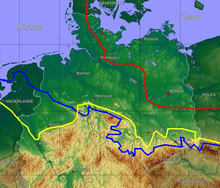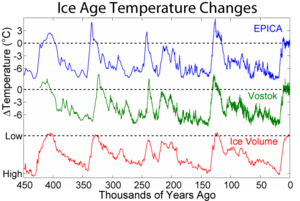Major ice ages
There have been at least five major ice ages in the earth's past (theHuronian, Cryogenian, Andean-Saharan, Karoo Ice Age and theQuaternary glaciation). Outside these ages, the Earth seems to have been ice-free even in high latitudes.[31][32]
Rocks from the earliest well established ice age, called the Huronian, formed around 2.4 to 2.1 Ga (billion years) ago during the early Proterozoic Eon. Several hundreds of km of the Huronian Supergroup are exposed 10–100 km north of the north shore of Lake Huron extending from near Sault Ste. Marie to Sudbury, northeast of Lake Huron, with giant layers of now-lithified till beds, dropstones, varves, outwash, and scoured basement rocks. Correlative Huronian deposits have been found near Marquette, Michigan, and correlation has been made with Paleoproterozoic glacial deposits from Western Australia.
The next well-documented ice age, and probably the most severe of the last billion years, occurred from 850 to 630 million years ago (the Cryogenian period) and may have produced a Snowball Earth in which glacial ice sheets reached the equator,[33] possibly being ended by the accumulation of greenhouse gases such as CO
2 produced by volcanoes. "The presence of ice on the continents and pack ice on the oceans would inhibit both silicate weathering and photosynthesis, which are the two major sinks for CO
2at present."[34] It has been suggested that the end of this ice age was responsible for the subsequent Ediacaran and Cambrian Explosion, though this model is recent and controversial.
The Andean-Saharan occurred from 460 to 420 million years ago, during the Late Ordovician and the Silurian period.
The evolution of land plants at the onset of the Devonian period caused a long term increase in planetary oxygen levels and reduction of CO
2 levels, which resulted in the Karoo Ice Age. It is named after the glacial tills found in the Karoo region of South Africa, where evidence for this ice age was first clearly identified. There were extensive polar ice caps at intervals from 360 to 260 million years ago in South Africa during theCarboniferous and early Permian Periods. Correlatives are known from Argentina, also in the center of the ancient supercontinent Gondwanaland.
The current ice age, the Pliocene-Quaternary glaciation, started about 2.58 million years ago during the late Pliocene, when the spread of ice sheets in the Northern Hemisphere began. Since then, the world has seen cycles of glaciation with ice sheets advancing and retreating on 40,000- and 100,000-year time scales called glacial periods, glacials or glacial advances, and interglacial periods, interglacials or glacial retreats. The earth is currently in an interglacial, and the last glacial period ended about 10,000 years ago. All that remains of the continental ice sheets are theGreenland and Antarctic ice sheets and smaller glaciers such as on Baffin Island.
Ice ages can be further divided by location and time; for example, the names Riss (180,000–130,000 years bp) and Würm (70,000–10,000 years bp) refer specifically to glaciation in the Alpine region. The maximum extent of the ice is not maintained for the full interval. The scouring action of each glaciation tends to remove most of the evidence of prior ice sheets almost completely, except in regions where the later sheet does not achieve full coverage.
There have been at least five major ice ages in the earth's past (theHuronian, Cryogenian, Andean-Saharan, Karoo Ice Age and theQuaternary glaciation). Outside these ages, the Earth seems to have been ice-free even in high latitudes.[31][32]
Rocks from the earliest well established ice age, called the Huronian, formed around 2.4 to 2.1 Ga (billion years) ago during the early Proterozoic Eon. Several hundreds of km of the Huronian Supergroup are exposed 10–100 km north of the north shore of Lake Huron extending from near Sault Ste. Marie to Sudbury, northeast of Lake Huron, with giant layers of now-lithified till beds, dropstones, varves, outwash, and scoured basement rocks. Correlative Huronian deposits have been found near Marquette, Michigan, and correlation has been made with Paleoproterozoic glacial deposits from Western Australia.
The next well-documented ice age, and probably the most severe of the last billion years, occurred from 850 to 630 million years ago (the Cryogenian period) and may have produced a Snowball Earth in which glacial ice sheets reached the equator,[33] possibly being ended by the accumulation of greenhouse gases such as CO
2 produced by volcanoes. "The presence of ice on the continents and pack ice on the oceans would inhibit both silicate weathering and photosynthesis, which are the two major sinks for CO
2at present."[34] It has been suggested that the end of this ice age was responsible for the subsequent Ediacaran and Cambrian Explosion, though this model is recent and controversial.
2 produced by volcanoes. "The presence of ice on the continents and pack ice on the oceans would inhibit both silicate weathering and photosynthesis, which are the two major sinks for CO
2at present."[34] It has been suggested that the end of this ice age was responsible for the subsequent Ediacaran and Cambrian Explosion, though this model is recent and controversial.
The Andean-Saharan occurred from 460 to 420 million years ago, during the Late Ordovician and the Silurian period.
The evolution of land plants at the onset of the Devonian period caused a long term increase in planetary oxygen levels and reduction of CO
2 levels, which resulted in the Karoo Ice Age. It is named after the glacial tills found in the Karoo region of South Africa, where evidence for this ice age was first clearly identified. There were extensive polar ice caps at intervals from 360 to 260 million years ago in South Africa during theCarboniferous and early Permian Periods. Correlatives are known from Argentina, also in the center of the ancient supercontinent Gondwanaland.
2 levels, which resulted in the Karoo Ice Age. It is named after the glacial tills found in the Karoo region of South Africa, where evidence for this ice age was first clearly identified. There were extensive polar ice caps at intervals from 360 to 260 million years ago in South Africa during theCarboniferous and early Permian Periods. Correlatives are known from Argentina, also in the center of the ancient supercontinent Gondwanaland.
The current ice age, the Pliocene-Quaternary glaciation, started about 2.58 million years ago during the late Pliocene, when the spread of ice sheets in the Northern Hemisphere began. Since then, the world has seen cycles of glaciation with ice sheets advancing and retreating on 40,000- and 100,000-year time scales called glacial periods, glacials or glacial advances, and interglacial periods, interglacials or glacial retreats. The earth is currently in an interglacial, and the last glacial period ended about 10,000 years ago. All that remains of the continental ice sheets are theGreenland and Antarctic ice sheets and smaller glaciers such as on Baffin Island.
Ice ages can be further divided by location and time; for example, the names Riss (180,000–130,000 years bp) and Würm (70,000–10,000 years bp) refer specifically to glaciation in the Alpine region. The maximum extent of the ice is not maintained for the full interval. The scouring action of each glaciation tends to remove most of the evidence of prior ice sheets almost completely, except in regions where the later sheet does not achieve full coverage.
Glacials and interglacials
See also: Glacial period and Interglacial
Within the ice ages (or at least within the current one), more temperate and more severe periods occur. The colder periods are called glacial periods, the warmer periods interglacials, such as the Eemian Stage.
Glacials are characterized by cooler and drier climates over most of the earth and large land and sea ice masses extending outward from the poles. Mountain glaciers in otherwise unglaciated areas extend to lower elevations due to a lower snow line. Sea levels drop due to the removal of large volumes of water above sea level in the icecaps. There is evidence that ocean circulation patterns are disrupted by glaciations. Since the earth has significant continental glaciation in the Arctic and Antarctic, we are currently in a glacial minimum of a glaciation. Such a period between glacial maxima is known as an interglacial. The glacials and interglacials also coincided with changes in Earth’s orbit called Milankovitch cycles.
The earth has been in an interglacial period known as the Holocene for more than 11,000 years. It was conventional wisdom that the typical interglacial period lasts about 12,000 years, but this has been called into question recently. For example, an article in Nature[35] argues that the current interglacial might be most analogous to a previous interglacial that lasted 28,000 years. Predicted changes in orbital forcing suggest that the next glacial period would begin at least 50,000 years from now, even in absence of human-made global warming[36] (see Milankovitch cycles). Moreover, anthropogenic forcing from increased greenhouse gases might outweigh orbital forcing for as long as intensive use of fossil fuels continues.[37]
See also: Glacial period and Interglacial
Within the ice ages (or at least within the current one), more temperate and more severe periods occur. The colder periods are called glacial periods, the warmer periods interglacials, such as the Eemian Stage.
Glacials are characterized by cooler and drier climates over most of the earth and large land and sea ice masses extending outward from the poles. Mountain glaciers in otherwise unglaciated areas extend to lower elevations due to a lower snow line. Sea levels drop due to the removal of large volumes of water above sea level in the icecaps. There is evidence that ocean circulation patterns are disrupted by glaciations. Since the earth has significant continental glaciation in the Arctic and Antarctic, we are currently in a glacial minimum of a glaciation. Such a period between glacial maxima is known as an interglacial. The glacials and interglacials also coincided with changes in Earth’s orbit called Milankovitch cycles.
The earth has been in an interglacial period known as the Holocene for more than 11,000 years. It was conventional wisdom that the typical interglacial period lasts about 12,000 years, but this has been called into question recently. For example, an article in Nature[35] argues that the current interglacial might be most analogous to a previous interglacial that lasted 28,000 years. Predicted changes in orbital forcing suggest that the next glacial period would begin at least 50,000 years from now, even in absence of human-made global warming[36] (see Milankovitch cycles). Moreover, anthropogenic forcing from increased greenhouse gases might outweigh orbital forcing for as long as intensive use of fossil fuels continues.[37]
Positive and negative feedback in glacial periods
Each glacial period is subject to positive feedback which makes it more severe and negative feedback which mitigates and (in all cases so far) eventually ends it.
Each glacial period is subject to positive feedback which makes it more severe and negative feedback which mitigates and (in all cases so far) eventually ends it.





No comments:
Post a Comment